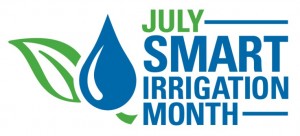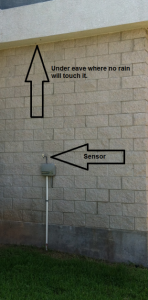 The first thing I saw when I turned my computer on Friday morning was emails from co-workers and City residents voicing concern about the irrigation systems they saw running this morning-after receiving 3+ inches of rain! It’s crazy, I know.
The first thing I saw when I turned my computer on Friday morning was emails from co-workers and City residents voicing concern about the irrigation systems they saw running this morning-after receiving 3+ inches of rain! It’s crazy, I know.
I don’t think anyone deliberately chooses to look silly or be wasteful by watering during or immediately after a huge rainstorm, they just don’t actively think about their irrigation system. For commercial properties, it’s bad for their image to look so wasteful, so I would think they’d be the first to jump on the efficient bandwagon and make sure the irrigation is always working as efficiently as possible. Unfortunately, that’s not always the case–and not just with commercial properties. This brings me to my second topic for Smart Irrigation Month-Upgrading your Irrigation System.
Updating, or improving irrigation systems, in my experience, tend to happen mainly when other big yard activities are going on, such as installing a pool or a new patio, or deck; replanting the sod or a huge remodel of all the landscaping in the yard. I don’t really see folks upgrading their systems just because there’s a new model of controller, or cool sensor. While irrigation is technology, apparently it’s not the cool technology that people invest in as frequently as their portable, hand-held electronic devices. I think it’s because we don’t visually see them or think of them nearly as much as our phones, or portable devices. They seem to do a good job-the grass is alive, so what’s to change? Well, technology has come a long way in the last decade in irrigation systems, which can save you money in water costs, conserve water, water more to the plant’s needs, and maybe have a little cool factor when you talk about your yard with your friends!
I don’t want this article to go too long, so I will focus only on sensors today.
Rain sensors are required on all newly installed irrigation systems since January 1, 2009. Though they have been around many years prior to that, they generally weren’t installed very frequently even though they are relatively cheap. 
- Sensors include rain sensors, freeze sensors, and soil moisture sensors. All of these are separate devices that are wired into the main irrigation controller, they do not come installed as part of the controller. Some controllers have a switch on them that says “sensor active” and “sensor bypass”, that doesn’t mean there is actually a sensor installed on your system.
A rain sensor turns off the irrigation system (if it’s running) after a specified amount of water has fallen or it delays the system from turning on after a specified amount of rain-so all of its actions are during or after the rain. There’s no weather forecasting, or determination of if watering is necessary. They have to be installed in an unobstructed location (like a fence or roofline) so that rain can fall in it. I’ve seen them under trees and under buildings! (see the picture for proof). But, it is better to have a working rain sensor than nothing, as I wish some commercial properties would have this morning! By the way, they’re pretty cheap-about $35-$75 retail.
Tremendous improvements have been made in the soil moisture sensor arena. A soil moisture sensor is actually buried in the ground about 6-inches deep (yes, you have to have that much soil for these to work!). They take moisture readings from the soil to determine if the soil is dry enough to require the irrigation to run; if it determines the soil doesn’t require additional water, it doesn’t allow the system to run. Ideally, you’d want more than one soil moisture sensor installed in your yard, one in sunny area and one in a shadier area, otherwise parts of your yard may be under- or overwatered. It’s more accurate watering than just watering because it’s a Saturday. It’s watering because the soil actually is dry. They are a little more costly than rain sensors, but they provide a more effective use of water.
Freeze sensors do not allow an irrigation system to turn on when temperatures reach a specific degree, usually around 40° F. These aren’t that common to have at homes, because we just turn off our irrigation systems for the winter. Commercial properties tend to water more year-round and would benefit from a freeze sensor to prevent the irrigation from freezing and causing a hazard.
The City’s Efficient Irrigation Rebate provides a rebate of 75% of the purchase cost of a sensor for your existing irrigation system, so if you don’t currently have a working one, please get one and apply for the rebate!


